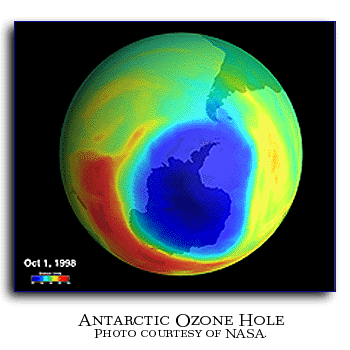The term Global Warming refers to the observation that the
 atmosphere near the Earth's surface is warming, without any implications for the cause or magnitude. This warming is one of many
kinds of climate change that the Earth has gone through in the past and will continue to go through in the future.
atmosphere near the Earth's surface is warming, without any implications for the cause or magnitude. This warming is one of many
kinds of climate change that the Earth has gone through in the past and will continue to go through in the future.Temperature increases will have significant impacts on human activities: where we can live, what food we can grow and how or where we can grow food, and where organisms we consider pests can thrive. To be prepared for the effects of these potential impacts we need to know how much the Earth is warming, for how long the Earth has been warming, and the cause of the warming. Answers to these questions provide us with a better basis for making decisions related to issues such as water resource management and agricultural planning.
How is it related to Greenhouse Warming and Global Warming?
The Greenhouse Effect is a term that describes how
water vapor, carbon dioxide, and other gases in the atmosphere help  maintain the temperature at the Earth's surface. The atmosphere approximates the function of a greenhouse by first letting sunlight (solar or short wave radiation) pass through
to warm the Earth, while absorbing much of the heat (thermal or long wave radiation) radiated up from the surface of the Earth.
maintain the temperature at the Earth's surface. The atmosphere approximates the function of a greenhouse by first letting sunlight (solar or short wave radiation) pass through
to warm the Earth, while absorbing much of the heat (thermal or long wave radiation) radiated up from the surface of the Earth.
Life on Earth would be very different without the Greenhouse Effect. The Greenhouse Effect serves to keep the long term annual average temperature of the Earth approximately 32°C higher than the Earth's temperature would be without the Greenhouse Effect. It is reasonable to expect that the Earth should warm as concentrations of greenhouse gases in the atmosphere increase above natural levels, much like what happens when the windows of a greenhouse are closed on a warm, sunny day. This additional warming is commonly referred to as Greenhouse Warming.
Greenhouse Warming is global warming due to increases in atmospheric greenhouse gases (e.g., carbon dioxide, methane, chlorofluorocarbons, etc.), whereas Global Warming refers only to the observation that the Earth is warming, without any indication of what might be causing the warming.
Global Warming is accepted as fact by most of the scientific community. However, Greenhouse Warming is more controversial because it implies that we know what is causing the Earth to warm. Although it is known for certain that atmospheric concentrations of these greenhouse gases are rising dramatically due to human activity, it is less well known exactly how increases in these greenhouse gases factor in the observed changes of the Earth's climate and global temperatures.
The ozone issue and Greenhouse Warming are related yet distinct scientific issues. In the lower atmosphere (called the troposphere), the ozone does act as a greenhouse gas, trapping outgoing radiation that would otherwise escape into space. Compared to carbon dioxide, ozone is a minor greenhouse gas. The significance of tropospheric ozone may be increasing however, due to the burning of fossil fuel which generates ozone (commonly recognized as a component of smog) into the lower atmosphere.

 For daily updated images of the ozone, please visit NOAA's Stratosphere: SBUV-2 Total Ozone Page with images of the ozone from the NOAA-14 Satellite by
clicking here or on image at right.
For daily updated images of the ozone, please visit NOAA's Stratosphere: SBUV-2 Total Ozone Page with images of the ozone from the NOAA-14 Satellite by
clicking here or on image at right.Ozone also plays a very important, natural role in the upper atmosphere (called the stratosphere). In the upper atmosphere, ozone acts as a shield against harmful ultraviolet (UV) radiation from the sun. Reductions in stratospheric ozone result in the increase of harmful UV radiation reaching the Earth's surface. Ninety percent of the atmospheric ozone is concentrated 10 to 40 kilometers above the Earth's surface. The biggest destroyer of the ozone in the stratosphere is the set of human produced chemical compounds (chlorofluorocarbons - CFC's), which act as greenhouse gases in the lower atmosphere. Extremely cold stratospheric temperatures over the North and South Poles, combined with solar radiation and atmospheric circulation, amplify the impact of ozone destroying chemical reactions, resulting in "Ozone Holes" over the Antarctica (pictured above) and the Arctic.
Back to top of page...
On to... "How do we study global warming?"

